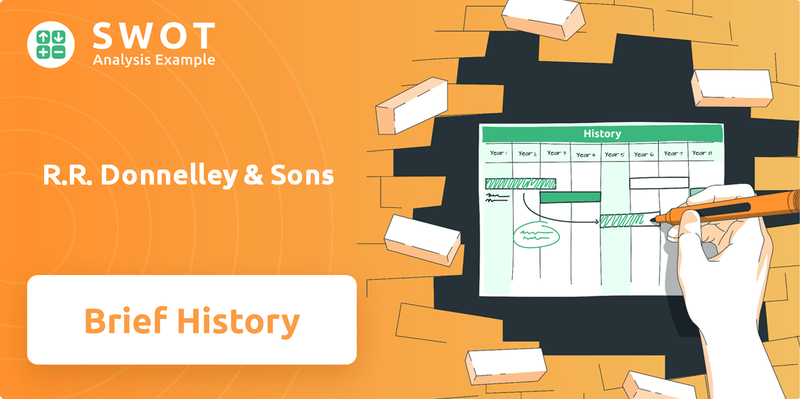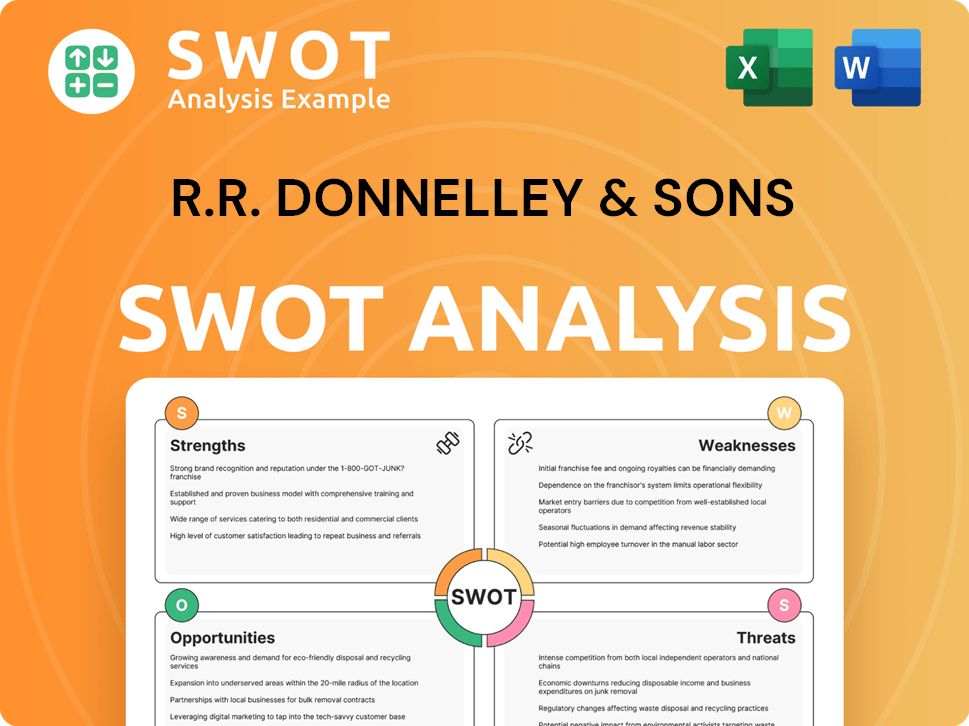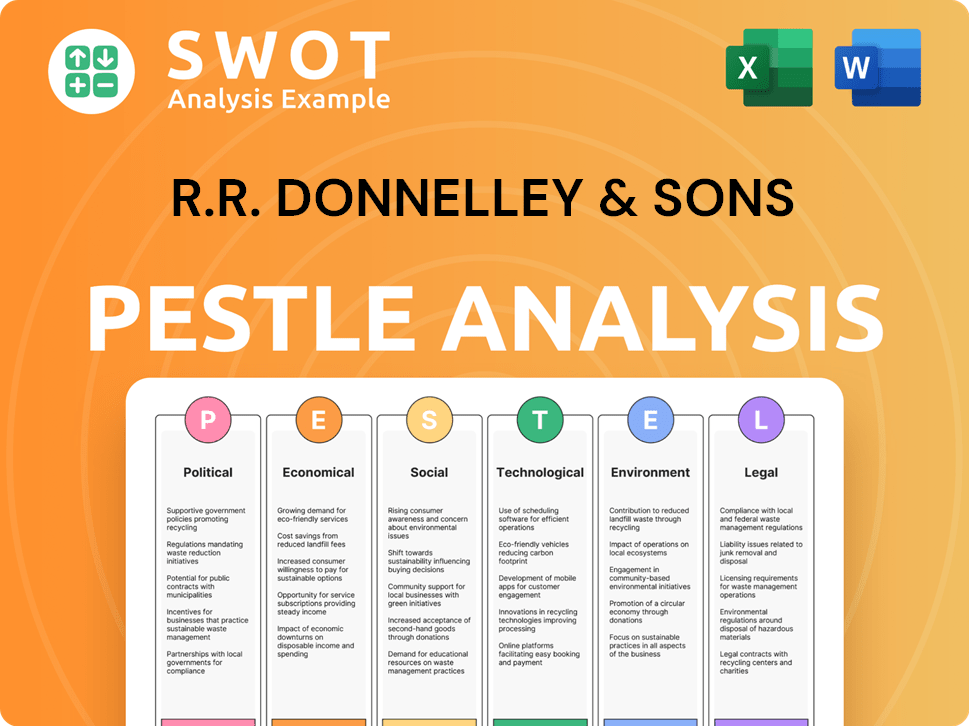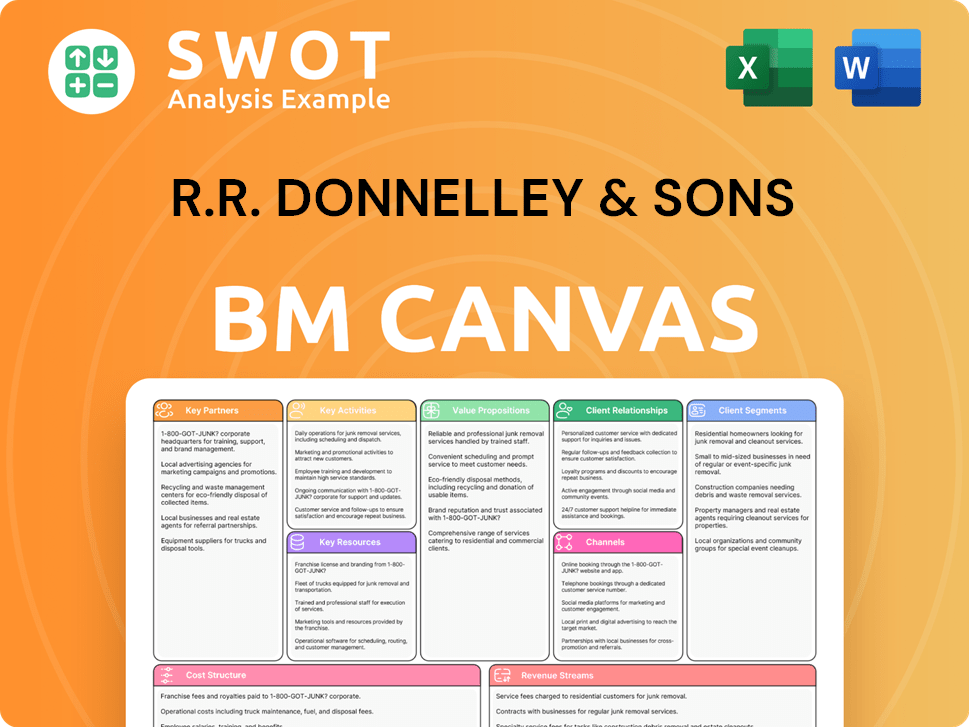R.R. Donnelley & Sons Bundle
How did R.R. Donnelley Shape the Printing Industry?
Journey back in time to explore the fascinating Donnelley history of R.R. Donnelley & Sons Company, a true giant in the commercial printing world. From its humble beginnings in 1864 Chicago, this printing company has weathered fires, economic downturns, and technological revolutions to become a global leader. Discover how R.R. Donnelley's resilience and innovation have left an indelible mark on the printing industry.

The R.R. Donnelley & Sons SWOT Analysis reveals the strategic landscape of this printing industry pioneer. Understanding the early history of R.R. Donnelley & Sons is crucial to grasping its evolution from a small Chicago printing shop to a multifaceted marketing and business communications powerhouse. This company profile highlights the key milestones and pivotal moments that have defined R.R. Donnelley's journey, including its role in book publishing and its impact on the printing industry.
What is the R.R. Donnelley & Sons Founding Story?
The story of R.R. Donnelley & Sons Company, a key player in the printing industry, began in 1864. Founded by Richard Robert Donnelley in Chicago, the company quickly grew from a small printing operation to a significant commercial printing and publishing enterprise. This early history of R.R. Donnelley & Sons laid the groundwork for its future success.
Richard Robert Donnelley, a former saddlemaker's apprentice, saw an opportunity to provide quality printing services in a growing city. His initial focus on commercial printing and publishing, including the Lakeside City Directory, set the stage for the company's evolution. Despite facing significant challenges, such as the Great Chicago Fire, Donnelley's resilience and determination helped the company thrive.
The company's early years were marked by both innovation and adaptation. The rebuilding of the printing shop after the fire, and the subsequent publication of the 'Lakeside Library,' showcased Donnelley's ability to overcome obstacles and capitalize on market opportunities. The evolution of the company's name to R.R. Donnelley & Sons Company in 1882 reflected its growing stature and the involvement of the next generation. The company's commitment to quality and innovation helped it become a leader in the printing industry.
R.R. Donnelley & Sons was founded in 1864 by Richard Robert Donnelley.
- Donnelley started as the printing operations manager for Church and Goodman.
- The company's initial focus was on commercial printing and publishing.
- The Great Chicago Fire of 1871 destroyed the original printing operations.
- The company's name evolved over time, becoming R.R. Donnelley & Sons Company in 1882.
The early success of R.R. Donnelley & Sons was significantly influenced by the economic and cultural context of late 19th-century Chicago. The city's rapid growth created a strong demand for printing services, which the company was well-positioned to meet. The company's ability to adapt and innovate, as demonstrated by its quick recovery after the fire and its expansion into publishing, was crucial to its early success. The company's history showcases its ability to overcome challenges and capitalize on opportunities in the printing industry. To learn more about the company's values, you can read about the Mission, Vision & Core Values of R.R. Donnelley & Sons.
R.R. Donnelley & Sons SWOT Analysis
- Complete SWOT Breakdown
- Fully Customizable
- Editable in Excel & Word
- Professional Formatting
- Investor-Ready Format

What Drove the Early Growth of R.R. Donnelley & Sons?
The early growth of R.R. Donnelley, a significant part of the Donnelley history, was marked by strategic expansions and technological advancements. The company's commitment to innovation and quality solidified its position in the printing industry. This period saw the establishment of key subsidiaries and facilities, shaping R.R. Donnelley's evolution into a leading commercial printing enterprise.
In 1881, Richard Robert Donnelley established the Chicago Directory Company as a separate entity. This strategic move highlighted the importance of specialized management within the printing and publishing sectors. The Chicago Directory Company later evolved into the Reuben H. Donnelley Corporation in 1917, which became an independent publisher of telephone directories, a concept pioneered by Donnelley in 1886 with the first Chicago Telephone Directory. This directory included a classified section, which was a precursor to the Yellow Pages.
R.R. Donnelley was among the first American printers to consolidate all aspects of the printing process under one roof. In 1897, the company commissioned architect Howard Van Doren Shaw to design a new facility in Chicago's Printing House Row, demonstrating its commitment to modern production methods. Upon Richard Robert Donnelley's death in 1899, his son Thomas E. Donnelley took over, steering the company into the new century with a focus on quality and a vision for the future. This era saw significant advancements in printing technology, enhancing efficiency and quality.
Early expansion included the establishment of the first company facility outside Chicago in Crawfordsville, Indiana, in 1921, to better serve customers. R.R. Donnelley also became a leader in commercial graphic design, hiring William A. Kittredge in 1922 to direct the Department of Design and Typography, which set industry standards for over three decades. The company continued to expand its reach, entering international markets in the 1980s with offices in Paris, Seoul, Mexico City, and Hong Kong to cater to the financial documentation needs of multinational corporations. In 1989, R.R. Donnelley expanded to Mexico with a new book printing plant in Reynosa.
A significant acquisition occurred in 1990 with the purchase of Meredith/Burda, a major catalog and magazine printer, for $550 million, the largest acquisition at that time. The company also relocated its corporate headquarters to The R.R. Donnelley Building at 77 West Wacker Drive in Chicago in 1992, consolidating corporate functions in the city's business district. For more insights into the competitive landscape, you can explore the Competitors Landscape of R.R. Donnelley & Sons.
R.R. Donnelley & Sons PESTLE Analysis
- Covers All 6 PESTLE Categories
- No Research Needed – Save Hours of Work
- Built by Experts, Trusted by Consultants
- Instant Download, Ready to Use
- 100% Editable, Fully Customizable

What are the key Milestones in R.R. Donnelley & Sons history?
The Donnelley history is marked by significant achievements and pivotal moments that have shaped the printing industry. From its early days in Chicago to its evolution into a global communications leader, R.R. Donnelley has consistently adapted and innovated. Its journey reflects a commitment to quality, technological advancement, and strategic restructuring to meet changing market demands.
| Year | Milestone |
|---|---|
| 1864 | R.R. Donnelley & Sons was founded in Chicago. |
| 1886 | Introduced the classified section in the first Chicago Telephone Directory. |
| 1903 | Initiated the Lakeside Classics series, showcasing a commitment to quality printing. |
| 1908 | Opened the Lakeside Press Apprentice School, one of the earliest structured industrial training programs. |
| 1983 | Undertook the massive printing contract for the AT&T divestiture prospectus, a landmark financial printing job. |
| 2016 | Completed a strategic split into three independent companies: R.R. Donnelley & Sons, LSC Communications, and Donnelley Financial Solutions. |
| 2024 | Celebrated its 160th anniversary, emphasizing a legacy of innovation and excellence. |
R.R. Donnelley's commitment to innovation is evident throughout its history. The company embraced new technologies, integrating sewing machines for binding in 1895 and installing Empire and Linotype machines to compete in the age of machine composition. As it moved into electronic communication and related services, it became a leader in diverse aspects of communications technology, expanding its offerings to meet evolving market needs.
R.R. Donnelley introduced the classified section in the first Chicago Telephone Directory in 1886, a groundbreaking concept that preceded the Yellow Pages.
In 1903, the company initiated the Lakeside Classics series, a tradition of producing fine reprints, showcasing its commitment to quality printing.
R.R. Donnelley opened the Lakeside Press Apprentice School in 1908, one of the earliest structured industrial training programs, to professionalize its workforce and ensure high-quality craftsmanship.
In 1983, R.R. Donnelley's Financial Printing Services Group undertook the massive printing contract for the AT&T divestiture prospectus, the largest financial printing, binding, and distribution job of its time, involving 3.6 million copies.
The company has consistently adopted new technologies, integrating sewing machines for binding in 1895 and installing Empire and Linotype machines to compete in the age of machine composition.
RRD is investing in first-to-market robotic technologies and advanced digital print presses from HP to transform its Austell, GA facility into a state-of-the-art commercial print hub, with upgrades expected to be complete in the first half of 2025.
Donnelley & Sons Chicago history includes navigating significant challenges. The Great Chicago Fire of 1871 destroyed its operations, but the company quickly rebuilt. More recently, the company has faced market shifts and strategic restructuring. The 2016 split into three independent companies and the 2019 exit from the Brazilian market reflect efforts to adapt and streamline operations.
The Great Chicago Fire of 1871 was an early, devastating setback, destroying its operations, but Donnelley quickly rebuilt.
In the early 1900s, the company resisted disruptions from unionized printers and by 1907, severed all ties with printing unions, which were then leaders in apprenticeship programs.
In 2015, the company announced a significant strategic pivot, splitting into three independent companies: R.R. Donnelley & Sons, LSC Communications, and Donnelley Financial Solutions, a separation completed in October 2016.
The company also exited the Brazilian market in 2019 and closed a plant in Lewisburg in November 2021.
RRD is investing in first-to-market robotic technologies and advanced digital print presses from HP to transform its Austell, GA facility into a state-of-the-art commercial print hub, with upgrades expected to be complete in the first half of 2025.
In 2024, RRD celebrated its 160th anniversary, emphasizing a legacy of innovation and excellence.
To understand the R.R. Donnelley & Sons company profile and its market positioning, consider reading about the Target Market of R.R. Donnelley & Sons.
R.R. Donnelley & Sons Business Model Canvas
- Complete 9-Block Business Model Canvas
- Effortlessly Communicate Your Business Strategy
- Investor-Ready BMC Format
- 100% Editable and Customizable
- Clear and Structured Layout

What is the Timeline of Key Events for R.R. Donnelley & Sons?
The Donnelley history is a story of resilience and innovation in the printing industry. Founded in Chicago in 1864 by Richard Robert Donnelley, the company quickly recovered from the Great Chicago Fire of 1871, re-establishing its operations. Over the years, it expanded its services from telephone directories to high-quality book printing, including the Lakeside Classics series, and became a major player in commercial printing. The company's evolution includes significant milestones such as the AT&T divestiture prospectus printing in 1983 and major acquisitions like Meredith/Burda in 1990, shaping its legacy in the Chicago printing scene and beyond.
| Year | Key Event |
|---|---|
| 1864 | Richard Robert Donnelley founded the company in Chicago. |
| 1871 | The Great Chicago Fire destroyed the company's operations, which were quickly re-established. |
| 1886 | The company produced the first Chicago Telephone Directory, including a classified section. |
| 1890 | The firm was formally incorporated as R.R. Donnelley and Sons Company. |
| 1903 | The Lakeside Classics series began, showcasing commitment to fine printing. |
| 1908 | The Lakeside Press Apprentice School was opened, a pioneering industrial training program. |
| 1921 | R.R. Donnelley opened its first plant outside Chicago in Crawfordsville, Indiana. |
| 1983 | The Financial Printing Services Group handled the massive AT&T divestiture prospectus printing. |
| 1989 | R.R. Donnelley expanded into Mexico with a new book printing plant. |
| 1990 | Acquired Meredith/Burda for $550 million, its largest acquisition to date. |
| 2016 | The company completed its separation into three independent entities: R.R. Donnelley & Sons, LSC Communications, and Donnelley Financial Solutions. |
| 2024 (March 18) | RRD announced the acquisition of digital and print marketing businesses from Vericast Corp. |
| 2024 (June) | RRD expands production capacity with over 15 new HP Indigo and PageWide Presses across North America, China, and Central America. |
| 2024 (July 22) | RRD finalizes the acquisition of digital and print marketing businesses from Vericast Corp, expanding its digital marketing capabilities. |
| 2024 (December 20) | RRD announces its definitive agreement to acquire Williams Lea, a provider of tech-enabled business support services. |
| 2025 (January 31) | RRD successfully closes the acquisition of Williams Lea, strengthening its Digital, Creative, and Business Support Services segment. |
| 2025 (February 6) | RRD announces investment in robotic technologies and advanced digital print presses for its Austell, GA facility, with upgrades expected in the first half of 2025. |
| 2025 (March 11) | RRD is scheduled to host an Investor Day to provide an update on strategic goals and an overview of its three business segments. |
| 2025 (April 17) | RRD debuts Iridio℠, a unified marketing solutions partner. |
R.R. Donnelley is concentrating on bolstering its core business and expanding revenue through higher-value offerings. This strategic shift includes a focus on improving financial flexibility, such as debt reduction. The company is adapting to meet evolving customer demands in the dynamic print and packaging sector.
The acquisition of Williams Lea, finalized in January 2025, is a key move to enhance its digital, creative, and business support services. This strategic addition positions R.R. Donnelley as a transformation partner for business support and productivity solutions. The move underscores the company's commitment to expanding its service offerings.
Ongoing investments in advanced digital printing and robotic technologies, especially at the Austell, GA facility, highlight R.R. Donnelley's commitment to innovation and efficiency. These investments are crucial for maintaining a competitive edge in the evolving print and packaging industry, ensuring R.R. Donnelley's ability to meet future demands.
The company anticipates a profit of 179.73 million USD in 2025, a 35.06% increase from the previous year, reflecting its growth trajectory. This positive outlook is supported by strategic acquisitions and investments. According to the 'Future-Ready Supply Chain' report, 97% of survey respondents plan to reengineer their supply chains, showcasing R.R. Donnelley's strategic role in industry trends.
R.R. Donnelley & Sons Porter's Five Forces Analysis
- Covers All 5 Competitive Forces in Detail
- Structured for Consultants, Students, and Founders
- 100% Editable in Microsoft Word & Excel
- Instant Digital Download – Use Immediately
- Compatible with Mac & PC – Fully Unlocked

Related Blogs
- What is Competitive Landscape of R.R. Donnelley & Sons Company?
- What is Growth Strategy and Future Prospects of R.R. Donnelley & Sons Company?
- How Does R.R. Donnelley & Sons Company Work?
- What is Sales and Marketing Strategy of R.R. Donnelley & Sons Company?
- What is Brief History of R.R. Donnelley & Sons Company?
- Who Owns R.R. Donnelley & Sons Company?
- What is Customer Demographics and Target Market of R.R. Donnelley & Sons Company?
Disclaimer
All information, articles, and product details provided on this website are for general informational and educational purposes only. We do not claim any ownership over, nor do we intend to infringe upon, any trademarks, copyrights, logos, brand names, or other intellectual property mentioned or depicted on this site. Such intellectual property remains the property of its respective owners, and any references here are made solely for identification or informational purposes, without implying any affiliation, endorsement, or partnership.
We make no representations or warranties, express or implied, regarding the accuracy, completeness, or suitability of any content or products presented. Nothing on this website should be construed as legal, tax, investment, financial, medical, or other professional advice. In addition, no part of this site—including articles or product references—constitutes a solicitation, recommendation, endorsement, advertisement, or offer to buy or sell any securities, franchises, or other financial instruments, particularly in jurisdictions where such activity would be unlawful.
All content is of a general nature and may not address the specific circumstances of any individual or entity. It is not a substitute for professional advice or services. Any actions you take based on the information provided here are strictly at your own risk. You accept full responsibility for any decisions or outcomes arising from your use of this website and agree to release us from any liability in connection with your use of, or reliance upon, the content or products found herein.